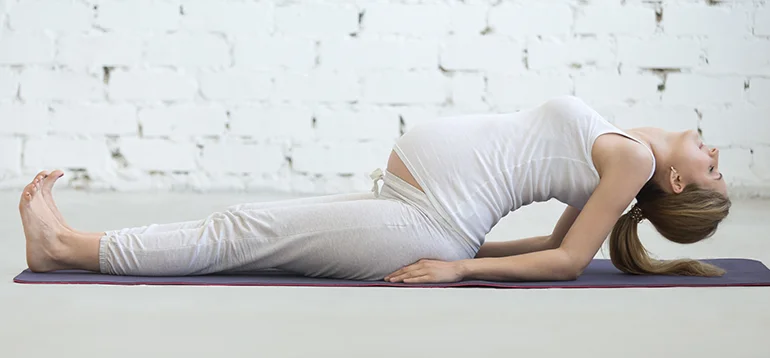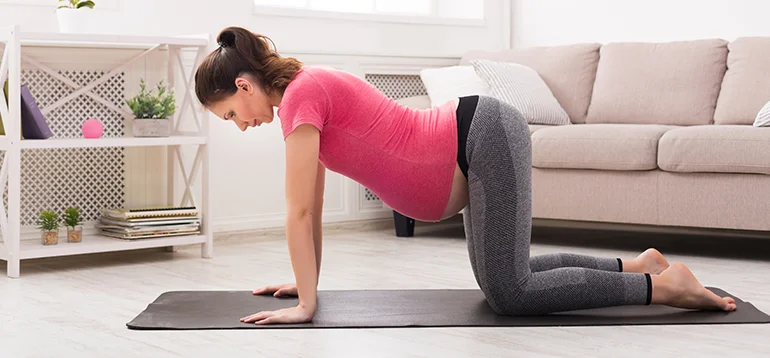Subscribe to get weekly insights
Always stay up to date with our newest articles sent direct to your inbox
Published on 21 Jun, 2022
Updated on 11 Apr, 2025
3412 Views
7 min Read
.jpg)
Written by Anjali Sharma
Reviewed by Akhil Pillai
favorite0Like
favoriteBe the First to Like
One of the most blissful phases of a woman’s life is pregnancy, which is all about excitement and admiration for the journey. At the same time, childbearing involves stressful days when to-be mothers run out of energy and motivation. This is the time when Yoga can help the most. As old as 5,000 years ago, Yoga surprises us with its many benefits. For pregnant women, yoga is an excellent source of improving sleep, reducing stress, anxiety, and pain while strengthening muscles and endurance.
The term yoga may sound quite exhausting or grueling, but there are many effortless yoga poses pregnant women can practice at home. Please note that you should consult your doctor before practicing any of the below-listed yoga postures to avoid unknown health complications
One of the most recommended yoga postures, Vakrasana, is a pregnancy stretch that improves flexibility in the spine and waist region. The spinal twist pose stretches multiple parts of your body, including the spine, legs, hands, and neck, along with the abdominal organs.
How to Do Vakrasana:
Step 1: Sit straight with your legs stretched parallel in front of you.
Step 2: Bend your right knee toward your chest, resting your foot’s sole on the ground.
Step 3: Inhale and slowly twist your torso towards the right.
Step 4: Try holding your right knee with your left hand while placing your right hand on the ground backside.
Step 5: Hold onto this position for 5 seconds, stretching your spine, neck, and hands comfortably.
Step 6: Exhale and slowly come back to the original position.
Step 7: Now repeat the exercise with the other side.
Pro tip: Don’t worry if you cannot touch your chest with the knee, as you don’t want to exert excessive pressure on your belly. Keep it slow and convenient for your health.
Ukatasana is one of the best yoga poses for pregnant women to strengthen the pelvic muscles, commonly known as the 'core'. While stretching your thighs, Ukatasana improves bladder and bowel movements, strengthening the pelvic muscles, adding strength to the weakening pelvic muscles during pregnancy.
How to Do Ukatasana:
Step 1: Stand straight with your feet parallelly apart as much as your shoulders.
Step 2: Lift your arms overhead with palms facing each other.
Step 3: Bend both knees to reach the squat position, like you are seated on a chair, putting most of your weight on the heels.
Step 4: Try to keep your knees as straight in line as your feet. Use your hips to balance your weight.
Step 5: Lean your upper body slightly forward.
Step 6: Try to hold this pose for at least 10 seconds with the help of your tailbone.
Pro tip: You can start practising Ukatasana by keeping your hands stretched in front of you. Once you are comfortable, you can switch to keeping your hands overhead.
Balasana is an effective yoga position for relieving gas while pregnant. Expecting mothers find this pose relieves gas while pregnant. Balasana relieves pressure on the belly and stretches the spine, thighs, and hips. This pose is also perfect for relaxing the back and reducing leg stress.
How to Do Balasana:
Step 1: Sit down with your knees folded with a straight back and hands on your lap.
Step 2: Keep your knees joined or slightly apart as per convenience.
Step 3: Exhale and slowly start lowering your upper body to fall on the ground with your hands stretching forward.
Step 4: Try to touch the ground with your forehead and hands while maintaining this position for at least 20 seconds.
Step 5: Inhale and slowly come back to the original position.
Step 6: Repeat the yoga asana 4-5 times.
Pro tip: Place a cushion in front of you to support your posture. Also, avoid doing this yoga asana if you feel excessive pressure on the belly.
Matsyasana is a very beneficial pose for you and your baby since it helps provide overall relief. It opens up your hips, stretches your abdominal muscles and relieves the stress on your back with a slight backbend.

How to Do Matsyasana:
Pro tip: Before practising Matsyasana, you should always gently stretch your neck, shoulders, and spine.
The cat and cow pose, or Bitilasana, is one such pose that works wonders on expecting mothers. It helps enhance your mood, energize your body, and even boost the production of breast milk. Additionally, it can be practiced in all stages of pregnancy, making it one of the best prenatal yoga poses.

How to Do Bitilasana:
Pro tip: Protect your neck by broadening across your shoulder blades and drawing your shoulders down, away from your ears.
During the first trimester of pregnancy, yoga can be a wonderful way to stay active, reduce stress, and support overall well-being. However, it is important to practice poses that are safe and suitable for early pregnancy.
Here are some of the safe yoga poses for the first trimester:
Before starting to practise these yoga poses, you should always consult with your specialised doctor first for the baby's safety.
Yoga can provide numerous physical, mental, and emotional benefits for pregnant women, making it a valuable practice during pregnancy. Here are some of the ways yoga helps:
Practicing yoga during pregnancy can be beneficial, but it is important to take certain precautions to ensure safety for both the mother and the baby.Here are key precautions pregnant women should keep in mind:
During pregnancy, certain yoga poses should be avoided to ensure the safety and comfort of both the mother and the baby. These poses may cause strain, discomfort, or risks to the developing baby.
Here is a list of yoga poses to avoid during pregnancy:
The journey to motherhood demands great care, caution, and monetary preparation. For you to enjoy the most of it without worrying about related healthcare expenses, Care Health Insurance brings ‘JOY– Our Dedicated Maternity Insurance.’ The JOY maternity cover promises complete health and financial security with comprehensive coverage for expecting mothers and their newborns. The plan includes several useful benefits, including cashless hospitalisation, in-patient care, newborn baby cover, multi-year facilities, and more.
So, safeguard your pregnancy journey by following a healthy lifestyle, practising yoga and exercises, and, most importantly, covering medical expenses with our valuable maternity insurance.
>> Also Read Why Yoga is Important for Cancer Patients?
Disclaimer: The above information is for reference purposes only. Kindly consult your general physician for verified medical advice. The health insurance benefits are subject to policy terms and conditions. Refer to your policy documents for more information.
favoriteBe the First to Like
Thyroid : मामूली नहीं हैं महिलाओं में थायराइड होना, जानें इसके लक्षण और घरेलू उपचार Vipul Tiwary in Diseases
शुगर कंट्रोल कैसे करे? जानें, डायबिटीज में क्या खाना चाहिए Vipul Tiwary in Health & Wellness
हाई ब्लड प्रेशर को तुरंत कंट्रोल कैसे करें? देखें इसके उपाय Vipul Tiwary in Diseases
पैरों में दर्द किस कमी से होता है? जानें, इसके घरेलू इलाज Vipul Tiwary in Health Insurance Articles
Say Goodbye to Low Estrogen Symptoms: Causes, Symptoms & Easy Lifestyle Fixes Jagriti Chakraborty in Diet & Nutrition
Gym Supplements: Muscle Magic or Marketing Madness? Leena Khowal in Diet & Nutrition
The Ultimate Guide to Black Salt Leena Khowal in Diet & Nutrition
Celery: A Crunchy Superfood with Surprising Health Benefits Leena Khowal in Diet & Nutrition
Prenatal yoga focusing on breathing, gentle stretches, and relaxation, such as cat-cow pose child's pose, and seated forward bends, is considered best.
The second trimester (4th-6th month) is the safest to start yoga, as the risk of miscarriage is lower, and the body is more stable.
Yes, Yoga is generally safe during pregnancy if done with precautions and under guidance.
Yes, Vajrasana can be done, but only if it is comfortable and there is no pressure on the abdomen.
Surya Namaskar can be modified and practised in early pregnancy if approved by a doctor, but avoid it in later stages.
Avoid sitting with crossed legs or in positions that restrict blood flow or put pressure on the abdomen.
Yes, sleeping on the right side is generally safe, but sleeping on the left is preferred for better blood flow to the baby.
Yes, folding legs is generally okay if it is comfortable and doesn’t restrict blood circulation.
Severe fatigue, swelling, contractions, dizziness, or any medical advice to rest indicate you should stop working.
Sleeping on the side with a pillow between your knees and supporting your back can help alleviate back pain.
Always stay up to date with our newest articles sent direct to your inbox
Loading...